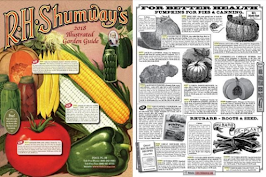 Growing flowers and vegetables from seed gives you more choices and saves money. Here are 10 great seed catalogs to check out. Jill Staake writes for
Growing flowers and vegetables from seed gives you more choices and saves money. Here are 10 great seed catalogs to check out. Jill Staake writes for and did all the work for us. The green links are live - just click & go. While the winter wind blows, gardeners everywhere turn to seed catalogs as they dream of the spring and summer ahead. The catalogs pile up, dog-eared and tattered, as growers plan for the future. Seed catalogs offer more choices than even the largest garden centers, and growing plants from seed is a great way to save money. We’ve rounded up 10 of our favorite seed catalogs you’ll want to have on hand as you prepare for the growing season. Tip: Want to save paper? All of these companies have websites, and many of them have digital versions of their catalogs.
and did all the work for us. The green links are live - just click & go. While the winter wind blows, gardeners everywhere turn to seed catalogs as they dream of the spring and summer ahead. The catalogs pile up, dog-eared and tattered, as growers plan for the future. Seed catalogs offer more choices than even the largest garden centers, and growing plants from seed is a great way to save money. We’ve rounded up 10 of our favorite seed catalogs you’ll want to have on hand as you prepare for the growing season. Tip: Want to save paper? All of these companies have websites, and many of them have digital versions of their catalogs.
 Prairie Moon Nursery
Prairie Moon NurseryIf you’re dedicated to planting natives in your garden, Prairie Moon should be your go-to resource. They offer an incredibly wide range of wildflowers and grasses, with information about native ranges and growing tips. They sell most seeds by packet or in bulk for larger plantings, as well as bare-root and potted plants for some species. Seeds to Try: Milkweed, multiple varieties. Monarch butterflies need native milkweed throughout their range. Prairie Moon offers a dozen different species of milkweed seeds, covering much of the country.
Select Seeds Flower lovers will revel in Select Seeds’ offerings. They specialize in fragrant, old-fashioned blossoms like those that filled your grandmother’s garden. Select Seeds also has rare finds and rediscovered antique heirlooms, like Job’s Tears (Coix lacryma-jobi), one of the oldest grasses in cultivation. Veggie lovers, rejoice! Territorial Seed’s catalog has more than 100 pages of vegetable and herb seeds and plants to choose from. Some of their offerings are truly unique, like oak trees inoculated with Bianchetto truffles so you can grow your own fungi delicacies. They also offer flowers and fruits. Seeds to Try: Goldilocks Squash, BuffaloSun Tomato
Burpee
 Heirloom seeds provide a direct connection to days past. Baker Creek sells over 1800 varieties of seed, specializing in types from the 19th century and earlier. A look through their catalog feels personal, as many photos include their family or employees showing off their offerings. Seeds to Try: Black Nebula Carrot
Heirloom seeds provide a direct connection to days past. Baker Creek sells over 1800 varieties of seed, specializing in types from the 19th century and earlier. A look through their catalog feels personal, as many photos include their family or employees showing off their offerings. Seeds to Try: Black Nebula CarrotRequest a Catalog
Johnny’s Selected Seeds
Johnny’s is an employee-owned company that takes special care to ensure all their seeds meet the Safe Seed Pledge. Their breeders use traditional methods to crossbreed new varieties, so if you’re concerned about GMO, you can trust Johnny’s. They offer a large selection of vegetables and flowers. Seeds to Try: Sun-Fill Purple Sunflower, Goldie Husk Cherry
Request a Catalog
R. H. Shumway’s Take a trip down memory lane with R. H. Shumway’s print catalog. Charming black and white drawings illustrate the vegetable offerings, while the flower pages have color illustrations. You can visit their website to see photographs of most varieties before ordering, if you like. Seeds to Try: Pride of Wisconsin Melon Request a Catalog
Harris Seeds
Based in Rochester, New York, Harris Seeds has been a resource for gardeners since it was founded in 1879. They now offer a large selection of vegetable and flower seeds, as well as live plants, bulbs, and gardening supplies. Request a Catalog

Park Seed
Park Seed is one of the biggest names in the business, and they’ve been in business since 1868. They carry an array of flowers, vegetables, plants, and gardening accessories. If you’re new to seed-starting, check out their Bio Dome System, which makes it easy to grow strong healthy plant from seed. Seeds to Try: Green Twister Coneflower, Honeybaby Butternut Squash Hybrid Request a Catalog

Annie’s Heirloom Seed The founder of Annie’s began the company when she realized just how much better heirloom vegetables tasted than commercially grown varieties. She had difficulty finding quality heirloom seeds, so she eventually decided to start her own company. Their carefully sourced seeds come from around the world, with new types added all the time. Request a Catalog
Sit Back and Dream...























